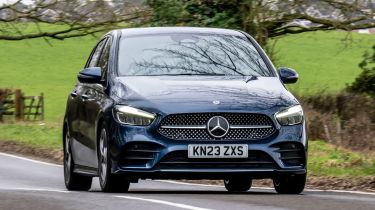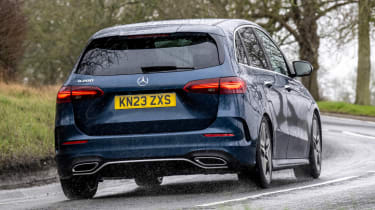Mercedes B-Class MPV - Engines, drive & performance
No sports car, but the B-Class MPV feels as nimble as the A-Class
Considering its extra mass, it's to the B-Class' credit that it feels very much like the Mercedes A-Class from behind the wheel. Though both cars share underpinnings, the B-Class is a taller machine, so you could excuse it for being rather wayward on a twisty road. Yet this isn’t the case.
On all B-Class models there’s not a huge amount of feel through the steering wheel, but the power assistance is well-judged to be neither too light nor too heavy, and there's a lot of bite from the front tyres when you push hard into a corner. The trade-off is a somewhat bouncy ride on British roads. This situation is improved on softer non-AMG Line versions, but overall the BMW 2 Series Active Tourer feels better able to soak up bumps.
Petrol engines
The B-Class petrol now comes exclusively in B 200 guise, with a 1.3-litre petrol engine and a seven-speed automatic gearbox. It produces 161bhp, but for short times its mild-hybrid technology can provide an electric boost of up to 13bhp, which also helps to smooth out gear changes. It feels plenty powerful enough, but the engine can sound a bit coarse at higher revs. Luckily this is only an issue when you need to accelerate hard, such as when joining a motorway or overtaking slower traffic.
More reviews
The B-Class was previously offered with a lower-powered 1.3-litre petrol engines along with a 221bhp 2.0-litre engine in the B 250.
Mercedes B-Class diesel engines
For 2023, the B 220 d is fitted with a 2.0-litre diesel engine serving up 148bhp, which is paired with an eight-speed automatic gearbox as standard. This can get it from 0-62mph in 8.5 seconds and on to a top speed of 136mph.
Before the facelift, B-Class buyers had three diesel engines to choose from. The B 180 d, B 200 d and B 220 d all used a 2.0-litre diesel that debuted in the latest Mercedes E-Class executive saloon. For this version of B-Class, the 2.0-litre diesel came with 114, 148 or 187bhp.
When we drove the B 200 d we found it impressively punchy and responsive, feeling just as fast as its 8.3-second 0-62mph sprint suggests and accelerating briskly without too much noise.
Hybrid engines
While now discontinued, the B 250 e combines the 1.3-litre turbo petrol engine with an electric motor, resulting in a combined total of 215bhp. So, not only is it the cleanest B-Class but the plug-in is also the fastest, getting from 0-62mph in 6.8 seconds. Don't mistake speed for excitement, though, because in 'Comfort' mode the A 250 e will favour electric power when possible.
When the petrol engine does kick in, it can seem rather coarse, particularly after the near-silent electric motor. The Mercedes does a good job of switching between power sources, however, and it's pleasant to drive smoothly. Body lean is slightly more pronounced owing to the plug-in powertrain's extra weight.










